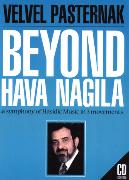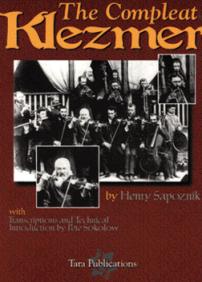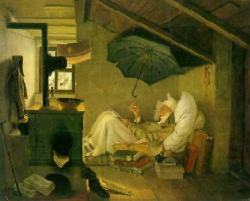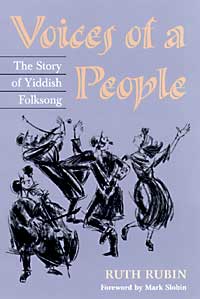"Mayn harts, mayn harts tsit tsu dir,
Azoyvi magnet tsu shtol;
Ich volt tsu dir amol gekumen,
Iz der veg tsu shmol."
(My heart is drawn to you, as a magnet is to steel; I
would come to you, but the road is too narrow.)
The Reb Yisroel Baal Shem-Tov (1700-60)
was the founder of the appealing Hasidic movement: Serve the Lord with joy
- come before Him with singing. He felt that a lively and joyous manner
was more acceptable to God than asceticism; melancholy and morbidity were sinful.
The hasidim shows his faith primarily through joy, and music is the natural
affiliation of joy. As the melody brings out the beauty in poetry, the dance
brings it to a climax. Singing and dancing was incorporated into religious
observance and liturgy. Their opponents criticized they were always singing,
dancing, clapping their hands, emitting wild cries during prayers. (Some
of the best drinking songs are credited to hasidim.)
But many hasidic leaders felt that melodies used for sacred purpose must be
protected to be become available to the public and used for secular purposes
or from being adopted and adapted by non-Jews. So little hasidic music found
its way into print and hundreds of "nigunim" [melodies] were lost forever. Velvel
Pasternak recalls his coming into the publishing and recording business:
 "In
early 1967, I received a rather frantic call from the mother of a bride in Sheboygan,
Wisconsin. Not having access to a band that could play traditional Jewish music
in Sheybogan, she scouted nearby Chicago, the city with the largest Jewish population
in the mid-west, in the hopes of finding a suitable instrumental ensemble. When
she asked various bandleaders if they knew Jewish music, she was informed that
they could play `Hava Nagila' and `Dayenu'. `Mr. Pasternak', she said, `can
these young men dance all night to only two songs?' The soon-to-be-bride offered
to purchase a book of traditional Jewish melodies. I could almost feel the depth
of her dejection through the telephone headset when I informed her that no such
collection existed. `How much will you charge to write out music for me?' she
asked. Her list of fifteen songs arrived several days later and I began transcribing
the melodies in pencil, adding guitar chords for accompaniment. Several months
later, I received a call from a woman in Florida, `We were at a wedding in Sheybogan
and we have the same problem in Florida' ..."
"In
early 1967, I received a rather frantic call from the mother of a bride in Sheboygan,
Wisconsin. Not having access to a band that could play traditional Jewish music
in Sheybogan, she scouted nearby Chicago, the city with the largest Jewish population
in the mid-west, in the hopes of finding a suitable instrumental ensemble. When
she asked various bandleaders if they knew Jewish music, she was informed that
they could play `Hava Nagila' and `Dayenu'. `Mr. Pasternak', she said, `can
these young men dance all night to only two songs?' The soon-to-be-bride offered
to purchase a book of traditional Jewish melodies. I could almost feel the depth
of her dejection through the telephone headset when I informed her that no such
collection existed. `How much will you charge to write out music for me?' she
asked. Her list of fifteen songs arrived several days later and I began transcribing
the melodies in pencil, adding guitar chords for accompaniment. Several months
later, I received a call from a woman in Florida, `We were at a wedding in Sheybogan
and we have the same problem in Florida' ..."
During the next year, Pasternak's music sheets made their way to bandleaders from
Los Angeles to Toronto. Finally, "Songs of the Hasidim" was financed by pre-paid
orders and he set up what is now Tara Publications.
Named after his daughter Atara, but according to legend, the granddaughter
of King David brought a torah to Ireland. (The Irish say Princess Tea brought
King David's harp, the Ark of the Covenant
and Jacob's pillar stone,
which later became the Scottish and British coronation stone, to the Hill
of Tara, gael. Tea Mur: Tea's Wall.)
Velvel Pasternak's Beyond Hava Nagila narrates, as joyous as hasidim
praise the Lord, his autobiography, the history and essence of hasidic music,
songs and background stories: The prayer "Kol Nidre" (All Vows), for
example, is chanted on Yom Kippur (Day of Atonement). The theme is woven throughout
Beethoven's C#minor string
quartet (opus 131). Arnold Schoenberg, who
re-converted to Judaism after being driven out of Germany by the Nazis, composed
it for chorus, orchestra and speaker. The Hebrew song "Ani Ma-amin"
(I believe) emerged from the Warsaw Ghetto (words by Maimonides). Thousands of Jews sang this melody as they marched
to their deaths in the gas chambers. When the disco hit "Genghis Khan" entered in the European Song Festival competition in 1979,
it appeared soon after with Yiddish lyrics which proclaim the coming of the
Messiah.
"Rabbi Yisroel Taub's
most famous `nigun' is the lengthy `Ezk'ro Hagodol' (the Great Ezk'ro). In 1913,
Rabbi Israel fell ill and was forced to travel to Berlin for medical treatment.
His doctors felt that his life could be saved only by the amputation of a leg.
The Rebbe agreed to the operation but with the provision that no form of anestesia
be used. During the removal of the leg, he composed this `nigun'. In the
room next to you, the surgeon told him, I have a patient who is a cabinet
minister. He constantly wails and moans, and I said to him, `You ought to be
ashamed of yourself. I have an older rabbi next door, and whenever he is in
pain he sings.' Rabbi Israel replied, I, too, moaned and wailed, but
my pain turned into song."
The most popular Jewish music in economical terms is klezmer, the traditional,
instrumental party music of Yiddish-speaking, Eastern European Jews. Its
main role was to play at weddings.
"Klezmer was the sound track to an event - one that often lasted several
days or even weeks - that included a broad range of activity and emotion, from
the most reflective and introspective moments to the most active and extroverted."
Seth Rogovoy's The Essential Klezmer,
including the history of old and new world klezmer, biographies of the major
revivalists, and a discography with extensive notes, is the respective diary
of the Jewish cultural revival and renaissance. 
"The whining-yet-laughing, self-deprecating melodies of the clarinets
were the musical equivalent of the great Jewish comics Groucho
Marx, Lenny Bruce,
and Woody Allen. The brassy ensembles
of trumpets, trombones, and tubas talking over each other were like a noisy
crowd of long-lost aunts, uncles, and cousins at a Jewish family reunion. The
soulful, achy violin lines atop the pulsing, jerky, forward-lurching rhythms
spoke with sensual intensity an demotional rawness - the voice of the Jewish
heart, bleeding but still beating."
Klezmer music is a fusion of the medieval Judeo-German music and the improvised
melodies of East and Southeast Europe. Its trademark is a haunting lament and
a lively dance, grievance followed by exultation. The tunes are often quite simple,
but richly decorated by ornamentation, phrasing and articulation. The fiddle once
was the leading instrument, later taken over by the clarinet. The human voice
as heard through the violin or clarinet gives the music such warmth, what makes
the music sing, laugh, and cry, sometimes all three simultaneously. Anti-Jewish
decrees and anti-Semitic progroms provoked a steady wave of emigration. From 1880
until 1924, 2.5 million Eastern European Jews made their way to the United States.
The music has
"been lost, forgotten, swept under the carpet, abandoned, left for
dead, and literally vaporized into smoke, dust, and ashes, along with the bodies
of the countless numbers of Jewish musicians piled into the crematoria of Auschwitz and other Nazi factories
of death."
But:
"Curiously, as the calendar turns from the twentieth to the twenty-first
century, we are witness to an odd, almost mind-boggling phenomenon. Musicians
of all colors, stripes, and nationalities are playing this lost, forgotten music
once again. Jews in their twenties are flocking to Yiddish-language classes
and buying klezmer CDs at the city's trendiest record stores. They are searching
for usable alternatives to religious orthodoxy and Zionism as the center of
Jewish identity."
In the 1970s the old 78 rpm records were discovered again. The
Klezmorim, Kapelye,
The Klezmatics, Brave
Old World, tough, furious, happy-go-lucky, coincide with the "zeitgeist".
"In America, klezmer has enjoyed three vital periods. The first was
a result of the mass immigration in the late nineteenth and early twentieth
centuries, when immigrant klezmorim carved their own musical niches at a time
when jazz was popular, variously resisting and integrating American influences
into their playing styles. The revival period began with performers engaged
in a roots-oriented exploration of traditional music. The revival fed into a
third period, in which the more talented and adventurous musicians among the
revivalists began adding their own musical backgrounds to that tradition, including
most obviously rock, jazz, and classical influences."
We shouldn't forget to take a look on tutorials and tune sheets, an essential
part of today's music teaching. The first popular anthology, 1924's "The International
Dance Folio", was a series of Yiddish instrumental music in simplified form.
But the older players would have already internalized this repertoire, while
for the younger players the book gave no sense of phrasing, ornamentation or
style. Clarinet and saxophon player Sid Beckerman
remarks:  Those
who could play the music didn't need the books and those who needed the books
couldn't play the music. Or saying it more rudely: Admitting that you
learned to play from a book, was like admitting you learned how to have sex
from a manual!
Those
who could play the music didn't need the books and those who needed the books
couldn't play the music. Or saying it more rudely: Admitting that you
learned to play from a book, was like admitting you learned how to have sex
from a manual!
Henry Sapoznik's and Pete Sokolow's The Compleat Klezmer is a more successful example,
giving hints for instruments, ornamentations (by all means - trill, gliss,
bend, chirp, but don't overdo it!), and the different "bulgars" and "freylekhs"
(round dances), "horas" and "zhoks" (3/8 dances), and "doinas" (improvisations),
and providing the background of the musicians attributed to the respective tunes.
Being it Harry Kandel's "Der Gasn Nigun", the
most popular zhok section in doina suites, or Abe Schwarz's "Tantz,
tantz, Yiddelekh" (Ma Yofus), the most popular, quintessential "Jewish melody"
before the advent of "Hava Nagila".
"Der Heyser Bulgar": Clarinetist Naftule Brandwein,
the favourite musician of Brooklyn's notorious "Murder, Inc.", was often playing
with his back to the audience to hide his fingering techniques. He performed
on-stage wearing an Uncle Sam costume made entirely of Christmas tree lights
and was very nearly electrocuting himself with his own perspiration.
"Dovid, shpil es nokh a mol": Upon his arrival at Ellis Island, David Tarras's bags were
all fumigated. His clothes survived, his clarinet didn't. But: Forget your
past, your customs, and your ideals. Do not take a moment's rest. Run. Do.
Tarras later stood in for Brandwein in Joseph Cherniavsky's "Yiddish-American
Jazz Band" whose outfit played concerts dressed alternately as Cossacks and
Hasids.
I was wondering when the mail service delivered a parcel which the US Postal
Service had declared "Religious Material". (It turned out to be the Tara books.)
So let us sing, and the Lord on high will understand us. God bless
you, T:-)M.
Pasternak, Velvel, Beyond Hava Nagila - A Symphony of Hasidic Music
in 3 Movements. Tara, Owing Mills, MD, 1999, ISBN 0-933676-78-6,
Paperback, 172 pp, $29.95 (CD included).
Rogovoy, Seth, The Essential Klezmer - A
Music Lover's Guide to Jewish Roots and Soul Music, from the Old World to the
Jazz Age to the Downtown Avant-Garde. Algonquin, Chapel Hill, NC, 2000, ISBN 1-56512-244-5,
Paperback, 281 pp, $15.95.
Rubin, Ruth, Voices of a People - The Story of Yiddish Folksong.
University of Illinois Press, Urbana
and Chicago, 2000, ISBN 0-252-06918-8, Paperback, 558 pp, $23.95.
Sapoznik, Henry, & Peter Sokolow, The Compleat Klezmer. Tara,
Owing Mills, MD, 1987, ISBN 0-933676-10-7, Paperback, 80 pp, $24.95 (CD included:
"Excerpts from 78 recordings of klezmer masters", Tara TM703-2).
Back to the content of FolkWorld
Features
To the content of FolkWorld No. 21
© The Mollis - Editors
of FolkWorld; Published 2/2002
All material published in FolkWorld is © The
Author via FolkWorld. Storage for private use is allowed and welcome. Reviews
and extracts of up to 200 words may be freely quoted and reproduced, if source
and author are acknowledged. For any other reproduction please ask the Editors
for permission. Although any external links from FolkWorld are chosen with greatest care, FolkWorld and its editors do not take any responsibility for the content of the linked external websites.
FolkWorld - Home of European Music

Layout & Idea of FolkWorld © The Mollis - Editors of FolkWorld
 "I remember my bar mitzvah. My parents
had hired one of the top New York City klezmer clarinetists to play at the reception.
So there he was on the bandstand blowing some of the best bulgars in the business
and all I wanted to do was to crawl into the nearest, deepest hole. Can't
this guy playing anything modern? I actually just wanted to be a normal
kid. He was playing klezmer music and I wanted rock'n'roll. But something's
changed. In the last decade, klezmer music, this traditional instrumental music
of the Jews of Eastern Europe, has attracted a robust interest in the American
Jewish community. From Sheepshead Bay to Seattle new klezmer musicians are appearing
and older ones reappearing. Growing audiences across the country are made up
of older folks who are reminded of their younger days, and younger folks for
whom these will someday have been the old days. The music was patiently waiting
for us to hear it again." (Henry Sapoznik)
"I remember my bar mitzvah. My parents
had hired one of the top New York City klezmer clarinetists to play at the reception.
So there he was on the bandstand blowing some of the best bulgars in the business
and all I wanted to do was to crawl into the nearest, deepest hole. Can't
this guy playing anything modern? I actually just wanted to be a normal
kid. He was playing klezmer music and I wanted rock'n'roll. But something's
changed. In the last decade, klezmer music, this traditional instrumental music
of the Jews of Eastern Europe, has attracted a robust interest in the American
Jewish community. From Sheepshead Bay to Seattle new klezmer musicians are appearing
and older ones reappearing. Growing audiences across the country are made up
of older folks who are reminded of their younger days, and younger folks for
whom these will someday have been the old days. The music was patiently waiting
for us to hear it again." (Henry Sapoznik)  Yiddish poet,
singer and folklorist Ruth Rubin (1906-2000), improperly labelled crusader
for the vanishing legacy of the Yiddish world (I don't think Jews have
much sympathy for "crusaders"), devoted her entire life to Yiddish folk song.
Rubin's 1970s Voices of a People is still the only general introduction
to Yiddish folksong.
Yiddish poet,
singer and folklorist Ruth Rubin (1906-2000), improperly labelled crusader
for the vanishing legacy of the Yiddish world (I don't think Jews have
much sympathy for "crusaders"), devoted her entire life to Yiddish folk song.
Rubin's 1970s Voices of a People is still the only general introduction
to Yiddish folksong.
 "In
early 1967, I received a rather frantic call from the mother of a bride in Sheboygan,
Wisconsin. Not having access to a band that could play traditional Jewish music
in Sheybogan, she scouted nearby Chicago, the city with the largest Jewish population
in the mid-west, in the hopes of finding a suitable instrumental ensemble. When
she asked various bandleaders if they knew Jewish music, she was informed that
they could play `Hava Nagila' and `Dayenu'. `Mr. Pasternak', she said, `can
these young men dance all night to only two songs?' The soon-to-be-bride offered
to purchase a book of traditional Jewish melodies. I could almost feel the depth
of her dejection through the telephone headset when I informed her that no such
collection existed. `How much will you charge to write out music for me?' she
asked. Her list of fifteen songs arrived several days later and I began transcribing
the melodies in pencil, adding guitar chords for accompaniment. Several months
later, I received a call from a woman in Florida, `We were at a wedding in Sheybogan
and we have the same problem in Florida' ..."
"In
early 1967, I received a rather frantic call from the mother of a bride in Sheboygan,
Wisconsin. Not having access to a band that could play traditional Jewish music
in Sheybogan, she scouted nearby Chicago, the city with the largest Jewish population
in the mid-west, in the hopes of finding a suitable instrumental ensemble. When
she asked various bandleaders if they knew Jewish music, she was informed that
they could play `Hava Nagila' and `Dayenu'. `Mr. Pasternak', she said, `can
these young men dance all night to only two songs?' The soon-to-be-bride offered
to purchase a book of traditional Jewish melodies. I could almost feel the depth
of her dejection through the telephone headset when I informed her that no such
collection existed. `How much will you charge to write out music for me?' she
asked. Her list of fifteen songs arrived several days later and I began transcribing
the melodies in pencil, adding guitar chords for accompaniment. Several months
later, I received a call from a woman in Florida, `We were at a wedding in Sheybogan
and we have the same problem in Florida' ..." 
 Those
who could play the music didn't need the books and those who needed the books
couldn't play the music. Or saying it more rudely: Admitting that you
learned to play from a book, was like admitting you learned how to have sex
from a manual!
Those
who could play the music didn't need the books and those who needed the books
couldn't play the music. Or saying it more rudely: Admitting that you
learned to play from a book, was like admitting you learned how to have sex
from a manual!
